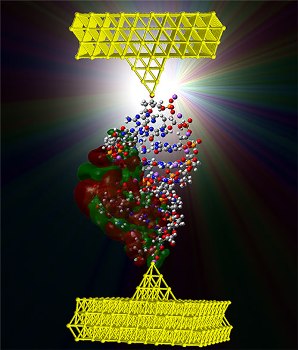Researchers from the University of California, Davis (UC Davis) and the University of Washington have shown the possibility of using DNA-based electromechanical switches for nanoscale computing.
 The A-form of DNA between two electrodes.
The A-form of DNA between two electrodes.
DNA is considered to be the molecule of life, and researchers have shown considerable interest in utilizing DNA as a nanoscale material in various applications.
In the current study, the team showed that controlling the structure of DNA could modulate the DNA’s conductance to be controlled reversibly, and this could aid the design DNA-based nanodevices. Such devices would not function in the same manner as present-day electronics, and instead would have a totally different pattern.
"As electronics get smaller they are becoming more difficult and expensive to manufacture, but DNA-based devices could be designed from the bottom-up using directed self-assembly techniques such as 'DNA origami'," said Josh Hihath, assistant professor of electrical and computer engineering at UC Davis and senior author on the paper. Folding DNA at the nanoscale level for creation of 2D and 3D shapes is known as DNA origami.
"Considerable progress has been made in understanding DNA's mechanical, structural, and self-assembly properties and the use of these properties to design structures at the nanoscale. The electrical properties, however, have generally been difficult to control," said Hihath.
DNA-based devices hold promise for nanoscale level fabrication, and could also help enhance the energy efficiency of electronic circuits. The last 40 years have seen significant reduction in the size of devices, however, it has also led to increase in on-chip power density. Researchers have been trying to find out innovative ways to enhance this efficiency.
"There's no reason that computation must be done with traditional transistors. Early computers were fully mechanical and later worked on relays and vacuum tubes," said Hihath. "Moving to an electromechanical platform may eventually allow us to improve the energy efficiency of electronic devices at the nanoscale."
The current study shows that DNA has the capacity to function as an electromechanical switch, and could help develop new methods in computing.
DNA has two stable conformations - the A-form and the B-form. The team concentrated on switching between these two conformations for developing DNA as a reversible switch. In the A-form DNA, different tilting and spacing exists between the base pairs. This version is comparatively more compact than the B-form, which is the usual DNA duplex that is related to these molecules.
When DNA is exposed to ethanol it is forced into A-form conformation leading to increased conductance, and when ethanol is removed, the DNA reverts back to its initial lower conductance value and B-form conformation.
Though this study proves the possibility of electromechanical switching in DNA, the team believes that a considerable amount of research has to be done to advance this finding for use in electronics applications.
In molecular electronics two major hurdles have to be crossed. In the same manner as for conventional electronics, billions of active molecular devices have to be combined into a single circuit, and then it must be possible to gate specific devices in large systems individually.
"Eventually, the environmental gating aspect of this work will have to be replaced with a mechanical or electrical signal in order to locally address a single device," noted Hihath.
The study paper has been published in the journal, Nature Communications.
Juan Manuel Artés and Yuanhui Li of the Department of Electrical and Computer Engineering at UC Davis, and M.P. Anantram and Jianqing Qi from the Electrical Engineering Department at University of Washington took part in the study.
The UC Davis Grant Research Investments in the Sciences and Engineering (RISE) and the National Science Foundation have funded the study.